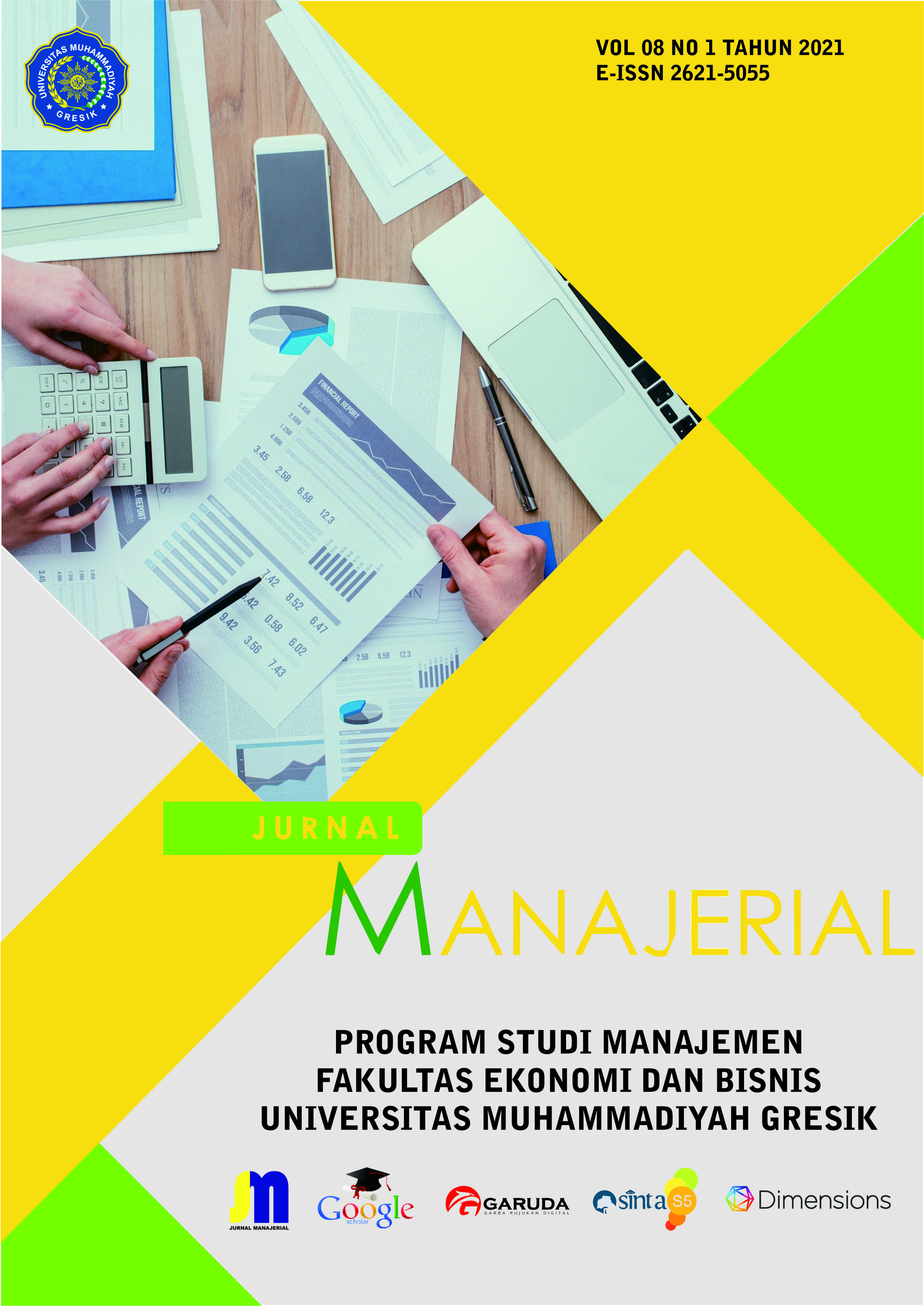Determinan Individu Mengadopsi Layanan E-Payment (Studi Pada Millenials Di Kabupaten Gresik)
DOI:
https://doi.org/10.30587/jurnalmanajerial.v8i01.1889Keywords:
E-payment, Service, Innovation, Diffusion, TheoryAbstract
Background – The development and use of financial technology services, especially in payment transactions (digital e-payments), are also influenced by the millennial generation who are now the majority generation of the population in Indonesia (Susenas, 2017). In its development, financial technology also continues to require innovation and development in the financial system so that it can be accepted by each individual user. So that research related to what factors are of interest to millennial individuals is important to do. Purpose – This study identifies the faktors that interest individuals in the millennial generation using e-payment services with the Innovation Diffusion Theory framework. Design/ Methodology/ Approach - The sample in this study were 159 users of e-payment services aged 20 years to 40 years who live or have activities in Gresik Regency and use e-payment applications obtained by convenience sampling technique. This research includes exploratory research. The method used in this research is faktor analysis. Result and Discussion - The results of the research and analysis that have been carried out as a whole, in determining the most dominant faktors can be seen in the total variance results in the total variance table explained, the economic benefit faktor which is the dominant faktor with a variance value of 40.550%, the payment instrument faktor with a variance value of 5,894%, information faktor with a variance value of 5,369%, technical, economic and social faktors with a variance value of 4,942% and the utility faktor which is the last faktor with a variance value of 4,676%. Conclusion – The most influential factors that lead to E-payment Adoption decisions sequentially are: economic benefit factor which is the strongest influencing factor, then the payment instrument factor is a strong influencing factor, in the third position there is the Information factor, in the fourth position is technical, social and economic factors. The utility factor which is the last factor that has a strong enough effect. Research Implication - The public can find out the things that cause them to adopt e-payments. The majority of respondents agreed that they get economic benefits when using e-payment in transactions for using financial services and make the respondents interested in adopting e-payment, therefore companies that provide e-payment must maintain the quality of the e-payment application
References
Al-Jabri, I.M., & Sohail, M.S. (2012). Mobile Banking Adoption: Application of Diffusion of Innovation Theory.
Anggraiawan, I. A., Isynuwardhana, D., & Mahardika, D. P. (2017). Determinan Perilaku Investror Individu Dalam Pengambilan Keputusan Investasi Saham Pada Investor Yang Terdaftar DI GI-BEI Telkom Unversity. E-Proceeding Of Mangement. 369-376.
Ghozali, Imam. (2001). Aplikasi Analisis Multivariate dengan Program SPSS. Semarang: Penerbit UNDIP
Indonesia, B. (2016, November 9). Sistem Pembayaran . Retrieved November 1, 2019, from Bank Indonesia: https://www.bi.go.id/id/peraturan/sistem-pembayaran/Pages/pbi_184016.aspx
Indonesia, B. (2017, November 29). Sistem Pembayaran. Retrieved November 1, 2019, from Bank Indonesia: https://www.bi.go.id/id/peraturan/sistem-pembayaran/Pages/PBI_191217.aspx
Indonesia, B. (n.d.). Statistik Sistem Pembayaran. Retrieved November 1, 2019, from Bank Indonesia: https://www.bi.go.id/id/statistik/sistem-pembayaran/uang-elektronik/contents/transaksi.aspx
Indrayati, R. N., & Aisyah, M. N. (2019). Determinan Minat Individu Menggunakan Layanan Financial Technology Dengan Kerangka Innovation Diffusion Theory. Jurnal Nominal , 209-222.
IMAM Ghozali. 2011. Aplikasi Analisis Multivariate dengan Program IMB SPSS 19. Semarang. Badan Penerbit UNDIP
Rahmatillah, I., Novirani, D., & Fitri, R. N. (2018). Analisis Pengaruh Perilaku Penggunaan Teknologi Fintech Pada Generasi Millenial DiKota Bandung. Seminar Nasional VII Manajemen dan Rekayasa Kualitas , B5.1-B5.8.
Rahmawati, F. (2018). Faktor-Faktor Yang Mempengaruhi Penerimaan Sistem Tiket Eletronik PT Transjakarta. Jakarta: Universitas Islam Negeri Syarif Hidayatullah.
Rogers, Everett M. (2003). Diffusion of Innovation. (5th ed). The Free Press. New York.
Sahin, I. (2006). Detailed Review Of Rogers’ Diffusion Of Innovations Theory And Educational Technology-Related Studies Based On Rogers’ Theory. The Turkis Online Journal Of Education Technology , 14-23.
Sarwono, J. (2010). Pengertian Dasar Structural Equation Modeling (SEM). Jurnal Ilmiah Manajemen Bisnis VII , 173-182.
Sholahuddin. (2017). Pengaruh Karakteristik Inovasi Terhadap Niat Mengadopsi Solopos Epaper. Surakarta: Pasca Sarjana Universitas Muhammadiyah Surakarta.
V. Wiratna Sujarweni. 2014. SPSS untuk Penelitian. Yogyakarta. Pustaka Baru Press






























 P-ISSN: 2354-8592 __ E-ISSN: 2621-5055
P-ISSN: 2354-8592 __ E-ISSN: 2621-5055 
